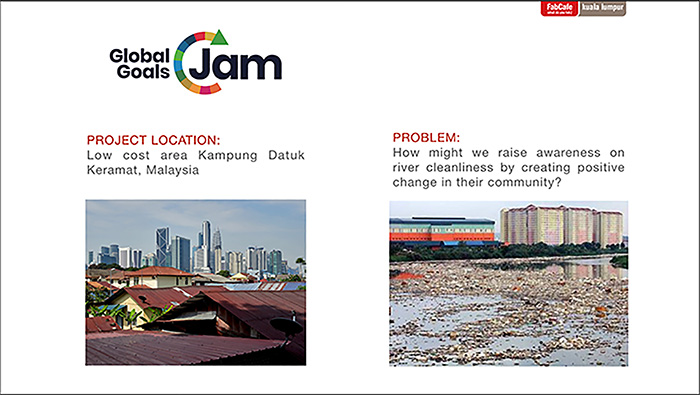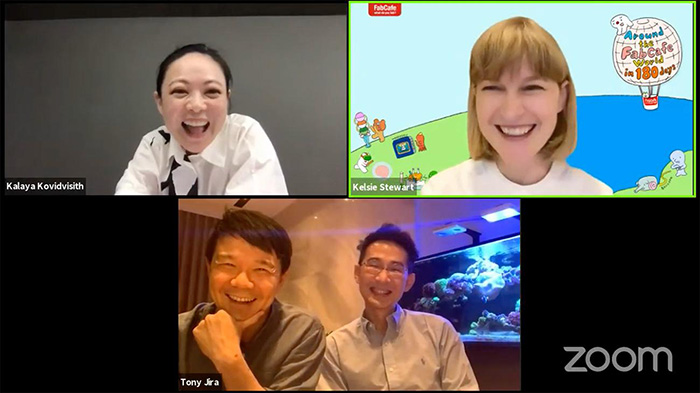Column
November 21, 2021
David Willoughby
Freelance Writer
In this ongoing event series, we invite each FabCafe to introduce the character of their local branch, show the projects they’re working on, and tell us how they’re responding to the unique challenges faced by their city or region. Vol. 3 saw us link up with FabCafe Kuala Lumpur to discuss the role of playfulness in design and creativity.
Andi Permadi and Gwyneth Jong are the duo behind workshop programme FabSpace, which ran for several years in the Isetan department store in KL. This gave them the platform to launch a standalone FabCafe in early 2020, just as Malaysia was introducing its first Covid lockdown. Untimely circumstances have not stopped Andi and Gwyneth from pursuing their goal of hosting projects and activities that incorporate play as a major theme.
Many of their ideas take consumption as a starting point for creation. Examples include laser shoe engraving in collaboration with Nike, and a workshop called Stool Hack in which participants craft new objects from a widely available source: the humble IKEA stool.

IKEA Stool Hack

Collaboration with a creator, Edmond Looi.
Andi and Gwyneth have a background in art direction and commercial design, and playfulness runs rampant in all of their projects. Car Topper is a recent collaboration with a 3D printing artist to produce seriously wild advertising signs – think roast chicken – to be mounted on commercial vehicles.

Their latest idea is Garbage Racer, a contest to design racing boats capable of collecting floating industrial waste from a local river.

Garbage Racer was prototyped at the Global Goals Jam held in September 2021.
Each event in this series invites a special guest to give a new perspective on the theme. This time we were joined by design studio Playfool, formed by Daniel and Saki Coppen, who met while studying at London’s Royal College of Art and now work out of Tokyo. Dan and Saki develop products and workshops that embrace core themes of exploration, experimentation, imagination, and creativity. Their YouTube channel launched only a year ago and has already racked up over 10M views.
Playfool want to promote creativity outside the “design bubble” and extend the benefits of play to adults as well as children. As we’ll see in the following discussion, they think it’s time we took play more seriously.
Everyone agrees that play is not the end goal. Instead, a play-based approach can free people to explore something or move them in surprising ways.
The way that we approach our projects is somewhat playful. It’s explorative, experimental, very iterative, and not afraid to fail. But we’re also about creating things to help others to play. So we’re play-based in our process, but we understand that it’s more of a mindset. Some people might describe a product or a piece of art as playful. We do not consider those things to be playful by our definition.
Dan, Playfool
For us, playability is more important. I understand that playful is a term used in aesthetics. But for us, when we say “playful”, we actually mean it as “playable”.
Saki, Playfool
The play-based approach is very effective in compelling people to actually do stuff. For example, the core idea behind Garbage Racer is that we want to get people to come together and clean the river. If we just say, “OK, let’s meet on a Saturday and clean the river together,” it becomes like a chore, and then suddenly your deadline seems more important. But when we turn it into a fun activity, suddenly your deadline is not that important and you would go join this game.
Gwyneth, FabCafe KL
It actually moves people to do something without us asking them. This is the power of playfulness.
Andi, FabCafe KL
Gwyneth and Andi highlight Volkswagen’s The Fun Theory, a brand campaign aimed at changing behaviour. One intervention called Piano Stairs transformed a flight of stairs into a fun activity.
Can playfulness stimulate innovation? By helping us understand what motivates people, it generates empathy – a great place to start when designing for others.
When you’re playing, all the happy hormones are there. You feel good and you want to do it. I think it boils down to being empathetic for whoever we’re designing for. We can put ourselves in their shoes and think about what makes them feel good.
Gwyneth, FabCafe KL
Just like you guys said, being playful means being curious or explorative. By trial and error, it eventually leads to new and innovative ideas.
Saki, Playfool
Through doing the workshop, we’ve seen people from all kinds of disciplines – rarely design or something creative – and we’re always surprised by how creative they can be. Just having people understand that they have the ability to be creative is very empowering. I think play has the power to evoke that, for them to understand the dormant creativity inside them.
Dan, Playfool
pw_video_new from Dan Coppen on Vimeo.
Playfool won the Good Design Award for their creative-thinking workshop designed to promote innovation in companies.
While FabCafe KL see play as a motivator in getting people to try new things, Playfool prefer to focus on the challenges it presents.
We do not equate play to fun. Play is hard work when it comes to using your creativity. Failing it can be very exhausting and it takes a lot of energy. That’s a challenge of play: it’s not always fun. It’s difficult and it’s about building a skill.
Dan, Playfool
Sometimes with experiments, writing down what you are going to do leads you in the wrong direction. You can’t plan it too much, which is also another challenge for our clients.
Saki, Playfool
Actually, there are risks in being playful all the time. Some people join a workshop because they want to learn something, but maybe our workshop is TOO fun and so it doesn’t actually feel like learning.
Andi, FabCafe KL
Gaming imposes control, while play brings freedom. Designers hoping to introduce play-based concepts should be aware of the difference.
One trend we’ve seen is the gamification of services, like ecommerce apps that include games just to make you stay in the app. For example, you have to spin a wheel to enter a lucky draw. That’s the gamification aspect of playfulness.
Gwyneth, FabCafe KL
Playfulness to me is not something that’s a game, but a thing that can actually change people’s behaviour to join something or do something.
Andi, FabCafe KL
I definitely agree with you. Play is not games. Even progress bars and things like Kickstarter, these kinds of visual indications to show progress can be considered gamification. It gets people addicted to certain things: seeing likes is like gaining points. That’s the dark side of playfulness – and that’s why our definition of play has transformed into one that’s more about creativity.
Dan, Playfool
We’re really interested in making playgrounds for adults. There are lots of playthings for kids. Play for adults is more towards gaming. It’s more controlled and there’s no creative play. Kids are creative for sure, but adults are too – they just don’t know if they are creative anymore.
Saki, Playfool

FabCafe KL workshops are designed to stimulate curiosity and playfulness and get people involved.
Playfool then explained how they developed Knotty, a simple block-based programming tool, based on what they see as the shortcomings of STEAM educational toys.
I felt like those STEAM toys were forcing kids to learn something, but learning comes with curiosity and should be self-directed. Kids should be asking questions and trying something new, then asking another question on top. This continuation is the learning process.
Saki, Playfool
With Knotty, we wanted to have a very unstructured approach and make it as simple and intuitive as possible. We wanted it to be comparable to just wooden building blocks, but have this element of technology to allow kids to explore and create with technology.
Dan, Playfool
Knotty from Dan Coppen on Vimeo.
Though not yet scaled up for production, Knotty is part of Playfool’s future plans.
We’ve discussed innovation, but what other benefits might play have for working teams? And how should organisations implement the play-based approach?
In our experience of doing these creative workshops – especially in Japan where there’s a pretty rigid hierarchy – it’s important that everyone is creating together on the same level. That managers and interns aren’t afraid to share ideas, fail together and learn things, with everyone working together and not just the design team doing it.
Dan, Playfool
Play is really chaotic. When we were studying at RCA, it was quite diverse. Who knows who is going to discover something. It doesn’t matter who you are, and that’s quite an important aspect of play. We can share the new discovery, and that will create a team.
Saki, Playfool
We try to play with something, but we also think about it beforehand. We research it and we really explore it before we do any prototyping, so we’re not simply playing.
Andi, FabCafe KL
The thinking seems to be that play situations are a way for team members to discover new competencies, regardless of job title or status. They’re also a place to experiment without fear of failure or judgement. Work, it seems, could benefit from more play.
That concludes our Kuala Lumpur edition of Around the FabCafe World in 180 Days. The full video is below for anyone who missed this event. FabCafe KL look forward to fully reopening the cafe and holding more workshops next year, while Playfool hope to collaborate with open-minded city councils on turning playgrounds for adults into reality.
-
FabCafe Bangkok opened in 2015, and its co-founder, Kalaya Kovidisith, has been creating various projects with her experience in architecture, design computation, and her creative planning skills. At this event, she talked about how materials became the future of digital fabrication together with Pattanapong Ranurak and Tanet Jirasavekdilok from Divana Wellness Co., LTD
-
In Zamora, the third most aged city in Europe, FabCafe Barcelona is now developing IoT and robots to support the elderly. In a future society where the value of living a more fulfilling life is more important than just convenience and efficiency, what will the relationship between robots, AI, XR, and other technologies, people, and cities look like? He discussed together with Prof. Junichi Rekimoto, the director of Sony CSL Kyoto Laboratory.
-
David Willoughby
Freelance Writer
David thinks and writes about sustainability, technology and culture, and has reported on many of our hackathons, talks and other events. He also works with Japanese companies to help tell their stories to the world.
David thinks and writes about sustainability, technology and culture, and has reported on many of our hackathons, talks and other events. He also works with Japanese companies to help tell their stories to the world.




